DIY bug hotel ideas are a wonderful way to invite beneficial insects into your garden while adding a unique decorative feature.
These simple structures create safe habitats for bees, ladybugs, and other helpful pollinators that support your plants by boosting pollination and controlling pests naturally.
You can design a bug hotel from basic materials like bamboo stalks, hollow wood, pinecones, or moss, and customize the size depending on your garden. Best of all, these projects take only an afternoon to complete and require minimal effort.
They also make a great family activity, encouraging kids to connect with nature and learn about insects in a fun, hands-on way. Once built, your bug hotel becomes both a home for pollinators and a talking point for visitors. It’s a win for your garden and the environment.
#1. Cinder Block Bee House
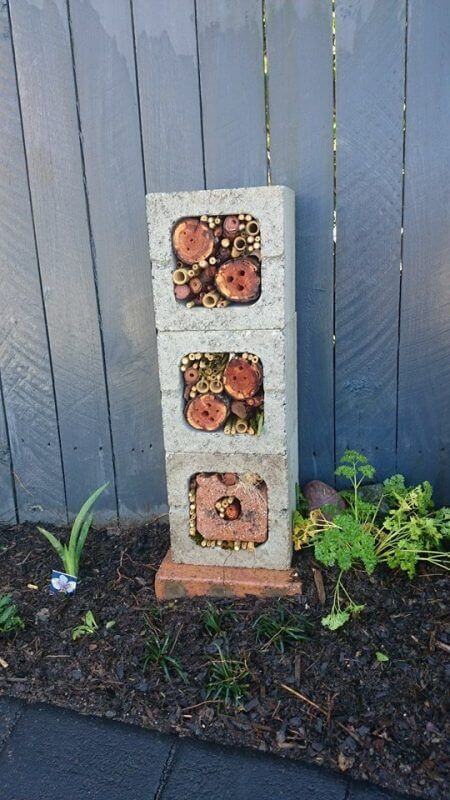
There’s something quietly satisfying about turning basic garden leftovers and humble cinder blocks into a thriving haven for pollinators and insects.
Materials Needed
- 3 concrete cinder blocks (16″ x 8″ x 8″)
- 1 paving stone
- Dried bamboo sticks
- Old logs
- Hollow stems (like elder or raspberry canes)
- Pine cones, bark pieces
Step-by-step Guide
Step 1: Choose a flat, sunny spot near pollinator-friendly plants. Place a solid brick or paver underneath the stack to keep it dry and elevated.
Step 2: Stack the three cinder blocks vertically with the hollow side facing forward. Make sure they are steady and level.
Step 3: Fill each opening with a snug arrangement of natural materials. Use a mix of drilled logs, bamboo, stems, and pine cones. Pack them tightly so they won’t shift in wind or rain.
Step 4: Check the balance of the stack and make sure rainwater can drain. If you live in a wetter area, consider covering the top block with a small roof tile or metal sheet to shield from excess rain.
#2. Old Juice Glass Bee House
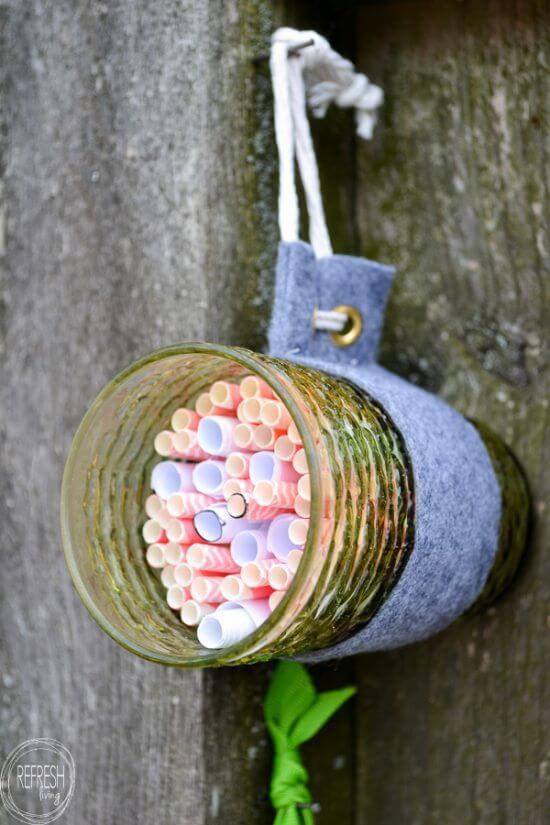
This little hanging jar bug hotel is perfect for tight spaces or balconies. It’s light, charming, and surprisingly effective.
Materials Needed
- 1 wide-mouthed glass jar (approximately 5–6″ in diameter)
- 40–60 biodegradable paper straws
- Felt strip (about 3″ x 12″)
- 1–2 grommets
- Sturdy string
- Glue
Step-by-step Guide
Step 1: Wrap the felt around the glass jar and secure it with glue or simply tie it tightly. Punch or insert a grommet at the top center of the felt to feed the rope through.
Step 2: Tie the rope through the grommet and create a secure loop or knot for hanging.
Step 3: Cut the paper straws to fit just inside the jar. They should sit snug and flush with the rim—this creates cozy nesting spots.
Step 4: Insert all the straws into the jar and gently pack them tight so they don’t shift.
Step 5: Hang the jar horizontally on a nail, fence hook, or garden post in a dry, sunny area. Make sure the jar is tilted slightly downward so rainwater can’t pool inside.
#3. Sculpture Garden With Insect Hotels

Built entirely from perforated bricks, it offers shelter to solitary bees, ladybugs, and even spiders.
Materials Needed
- 60 perforated red bricks standard size 8″ x 4″ x 2.25″
- Concrete adhesive
- Level and measuring tape
- Flat base
- Optional: steel rod
Step-by-step Guide
Step 1: Choose a flat, solid location to build your tower. Place a sturdy stone base or paver to act as the foundation.
Step 2: Begin stacking bricks in circular or symmetrical layers. Use concrete adhesive between each layer to ensure stability—especially in outdoor elements.
Step 3: Alternate the direction of brick holes between layers for visual texture and airflow. Make sure the holes are horizontal to provide nesting spots for insects.
Step 4: For taller builds, insert a metal rod through the center as you stack to give it additional support. Keep checking with a level to ensure it stays upright.
Step 5: Let the adhesive fully cure before allowing rain or wind exposure. You can even fill a few holes with bamboo tubes or straw for extra biodiversity.
#4 Bee House Made From Old Roof
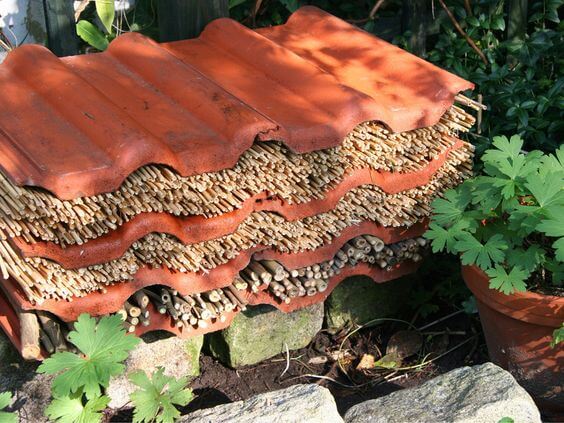
This layered structure made from terracotta roof tiles and hollow canes is one of the simplest—and most beautiful—bug hotels you can build.
Materials Needed
- Terracotta roof tiles (8–10 curved tiles)
- Bamboo canes (cut to 10–12 inches)
- Bricks or stone blocks (4–6 pieces)
- Garden gloves and pruning shears
- Optional: chicken wire
Step-by-step Guide
Step 1: Choose a shaded or semi-shaded garden spot. Stack bricks or stone blocks to create a slightly elevated, level base.
Step 2: Lay your first terracotta tile across the bricks. Tuck in tightly packed bundles of bamboo or reeds beneath it, filling the tile cavity.
Step 3: Continue layering tiles and filling them with cane bundles, alternating the direction if using curved tiles to create a stable pattern.
Step 4: Build up 3–4 layers high. Make sure the canes stay dry and snug; use a bit of wire to secure the structure if needed.
Step 5: Step back and enjoy the rustic charm. Soon you’ll see bees investigating their new cozy hideout.
#5. Wood Bee Hotel
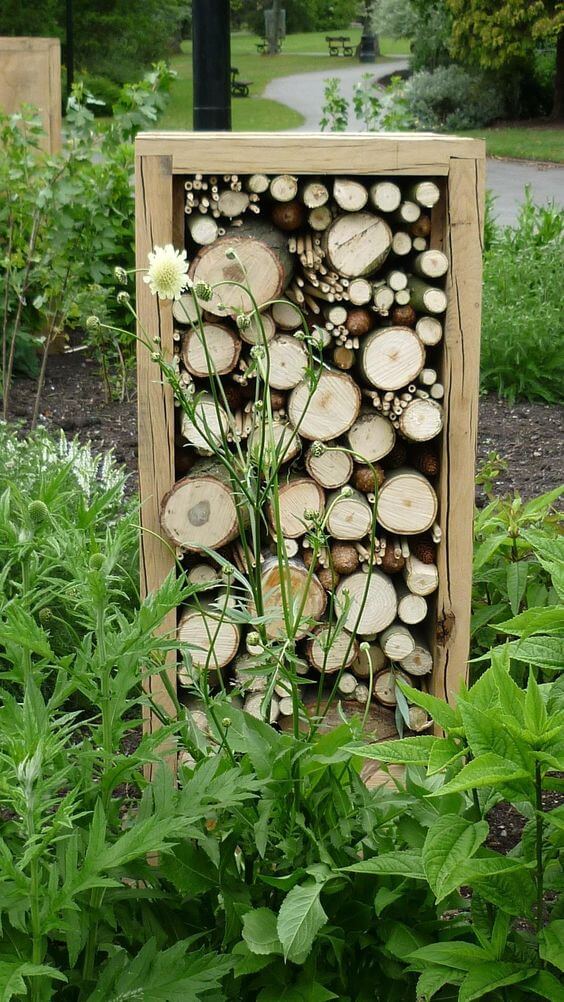
I’ve made a similar version for my pollinator patch—and honestly, the sight of bees checking in and out makes the entire effort worth it.
Materials Needed
- Untreated wood logs (varied diameters, 1″ to 6″, cut to 10–14″ lengths)
Get a mixed log pack - Drill with wood bits (⅛” to ⅜”) – essential for creating nesting tunnels
- Wooden frame or crate (16″ x 24″ x 8″) – you can build one or repurpose an old drawer Similar crate
- Natural filler: pinecones, bark chips, or twigs – optional, for added variety and microhabitats
Step-by-step Guide
Step 1: Begin by drilling holes into the cut ends of your logs—go about 3 to 4 inches deep, spacing holes at least 1/2″ apart.
Step 2: Place the logs tightly into the wooden frame, packing smaller twigs or pinecones into gaps for structural support and visual appeal.
Step 3: Position the finished structure in a sheltered area of the garden, with the open side facing south or southeast to catch the morning sun.
Step 4: Raise it slightly above ground level to prevent rot and keep the bugs cozy and dry.
#6. Bug Box
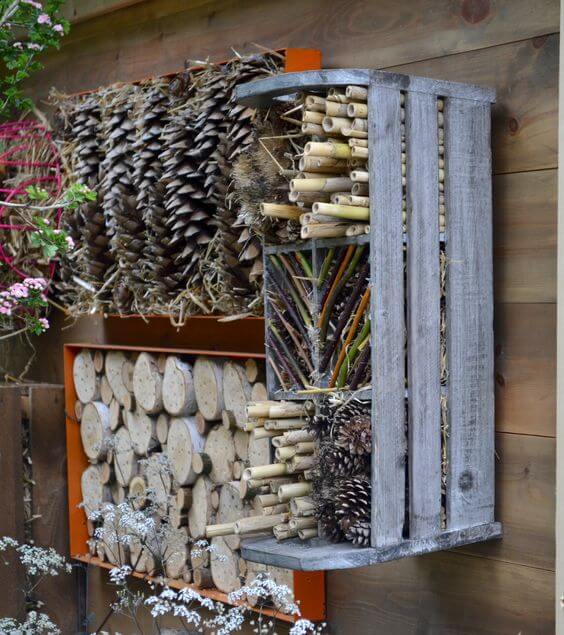
This vertical bug hotel made from a rustic wooden crate is one of my favorite multifunctional designs.
Materials Needed
- 1 wooden crate (roughly 18″ x 12″ x 6″)
- Dry bamboo canes, twigs, bark, pinecones, straw, and hollow stems
- Twine
- Optional: wire mesh
- Drill and screws
Step-by-step Guide
Step 1: Start by placing your wooden crate on its side to form a shelf-like shape. Decide whether to mount it vertically or horizontally based on your garden space.
Step 2: Fill each section with a different material—bamboo and hollow sticks are ideal for solitary bees, while pinecones and bark attract beetles and ladybugs. Use twine or small dividers if you want to organize it neatly.
Step 3: Optional: place a small mesh across open sections to keep loose straw and pinecones from falling out in wind or rain.
Step 4: Mount the crate securely to a fence or shed wall, ideally in a sunny and sheltered spot. Make sure the bottom stays dry to avoid rot or mold.
#7. Plastic Milk Jug Hotel
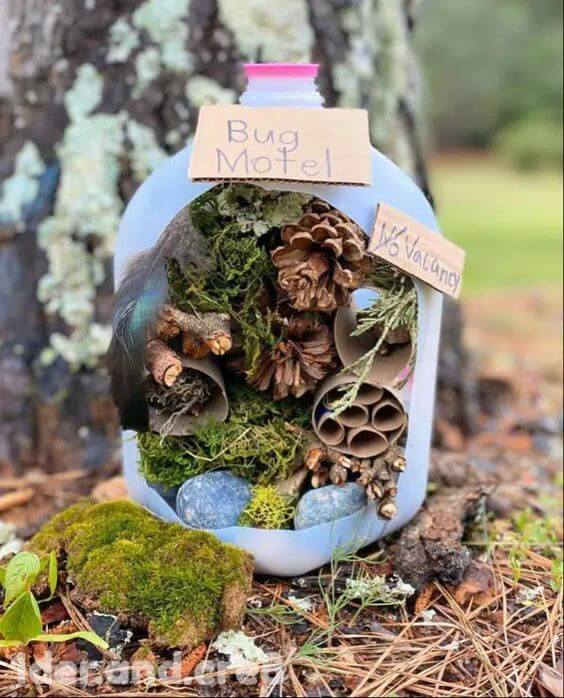
I love how approachable and budget-friendly this one is. It’s especially fun as a weekend project with kids.
Materials Needed
- 1 clean plastic milk jug (1-gallon)
- Cardboard tubes
- Pinecones, bark, twigs, moss, feathers, pebbles
- Optional: small cardboard
- Scissors
Step-by-step Guide
Step 1: Use scissors or a utility knife to carefully cut out a large rectangle from one side of the jug, leaving enough edge to maintain shape and structure.
Step 2: Begin stuffing your jug with layers of materials—tubes make cozy tunnels for solitary bees, while moss and pinecones are perfect for beetles and spiders.
Step 3: Decorate with small signs or bits of bark to add charm. This can be glued or taped to the jug itself.
Step 4: Place it at the base of a tree or bush where it’s shaded and protected. Add some stones around the base to stabilize it in wind.
#8. Hanging Plastic Bottle Bee House
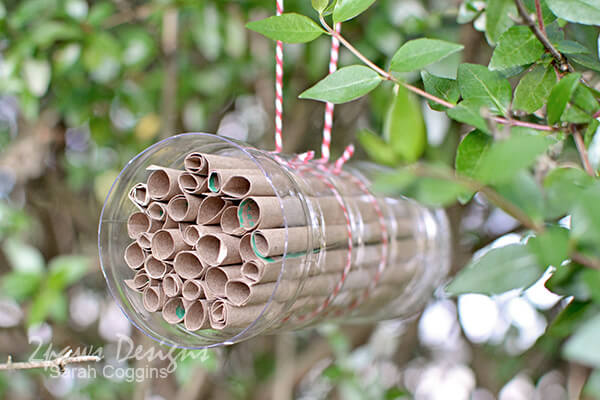
This adorable hanging bug hotel is one of the simplest ways to give nature a helping hand. It’s lightweight, recyclable, and easy enough for kids to help build.
Materials Needed
- 1 large clear plastic bottle (2-liter soda bottle)
- Paper straws, rolled kraft paper (about 5–7″ long)
- String
- Scissors
- Optional: hot glue gun
Step-by-step Guide
Step 1: Cut the top and bottom off your plastic bottle to make a clear tube.
Step 2: Roll kraft paper into tight tubes or use cut straws and cardboard tubes. Make sure they are all about the same length as your bottle’s body and tightly packed to stay in place.
Step 3: Fill the bottle with your paper tubes, snugly stacking them. If necessary, use a little tape or glue to keep them from shifting.
Step 4: Tie string around the bottle at both ends and suspend it horizontally from a branch in a sunny, dry spot, ideally near flowering plants.
#9. Old Wood Slice Insect Hotel
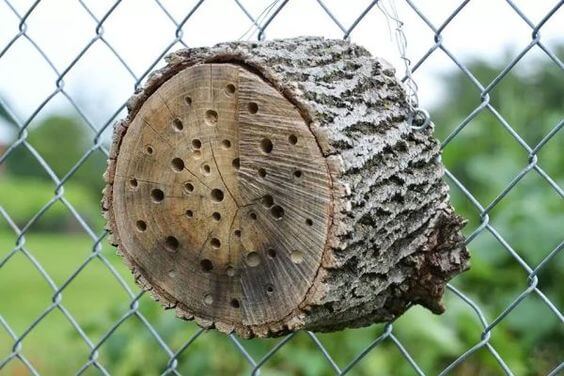
This rustic hanging bug hotel looks like part of the natural landscape and provides excellent nesting space for solitary bees and other beneficial insects.
Materials Needed
- One thick tree branch (around 6–10 inches in diameter, 4–6 inches deep)
- Drill with various-sized bits (1/8″, 3/16″, 1/4″)
- Sandpaper (optional)
- Hanging chain
- Eye screws
Step-by-step Guide
Step 1: Cut your log to the desired length if not already done. Make sure one end is flat and the bark remains intact.
Step 2: Using your drill, create holes of varying diameters (from 1/8″ to 1/4″) about 3–4 inches deep, spaced out across the cut face. Avoid drilling all the way through.
Step 3: Optional: lightly sand the inside edges of the holes to remove splinters that could harm insects.
#10. Wooden CD Crate Bee House
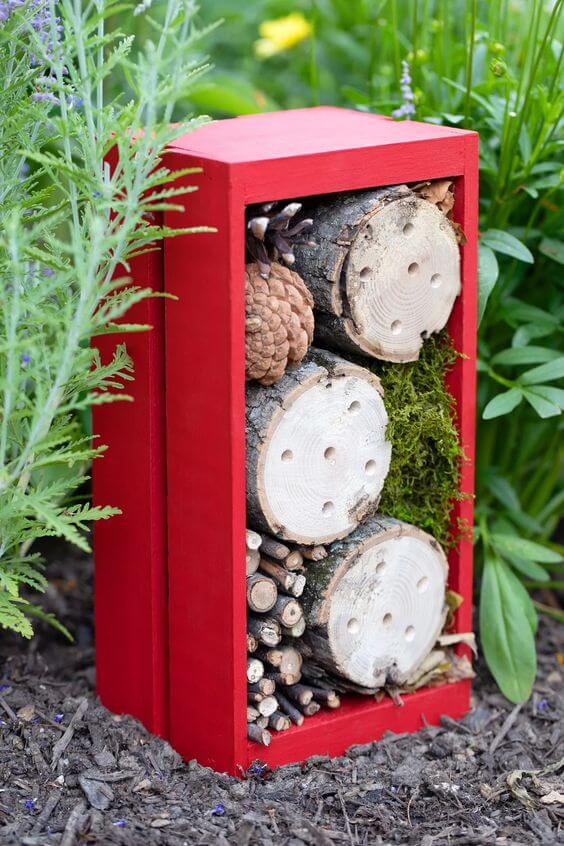
This cheery red bug hotel is not only a vibrant pop of color in your garden, but it’s also a warm welcome for helpful bugs like solitary bees, ladybugs, and lacewings.
Materials Needed
- Wooden frame (approx. 12–18 inches tall, 6–8 inches deep)
- Tree branch slices (cut to fit the frame’s depth, 3–4 pieces)
- Pinecones, dry moss, bark, small twigs
- Drill with 1/8″ and 1/4″ bits
- Red exterior paint (optional)
Step-by-step Guide
Step 1: Paint the outer wooden frame with red weather-resistant paint and let it dry fully.
Step 2: Cut logs to the same length as the depth of the frame. Drill multiple holes (3–4 inches deep) into the ends of each log to attract solitary bees.
Step 3: Arrange the logs vertically inside the frame. Fill in the remaining gaps with pinecones, moss, small sticks, or curled bark.
Step 4: Place the finished bug hotel in a sunny, sheltered garden spot, ideally 2–4 feet off the ground. Avoid heavy shade or too much moisture.
#11. Plastic Bottle With Pine Cone Insect Hotel
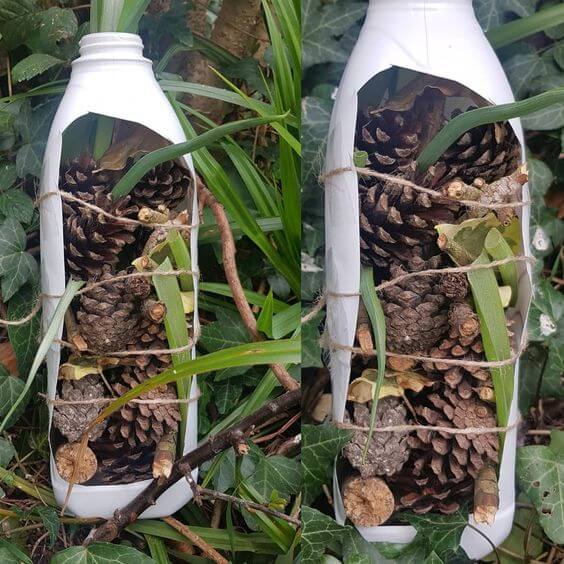
This simple yet effective bug hotel uses an old plastic bottle, a bit of twine, and natural materials—proving you don’t need fancy tools to support garden biodiversity.
Materials Needed
- 1 large plastic bottle
- Twine (about 3 feet)
- Natural fillers like: Pinecones (3–4), bark pieces, eaves, moss, dry grass, or straw
- Seed pods
Step-by-step Guide
Step 1: Clean and dry the bottle. Cut out a wide rectangular section on one side, leaving the back intact.
Step 2: Paint the exterior if desired for weather protection or aesthetic touch, then let it dry.
Step 3: Stuff the inside with pinecones, bark, twigs, and other natural materials—packing it tightly enough to stay in place, but loosely enough for insects to crawl in.
Step 4: Use twine or wire to secure the materials through holes or around the bottle if needed. Then, place the bottle horizontally or upright in a sheltered, shady garden spot.
#12. Wood And Branch Bee House
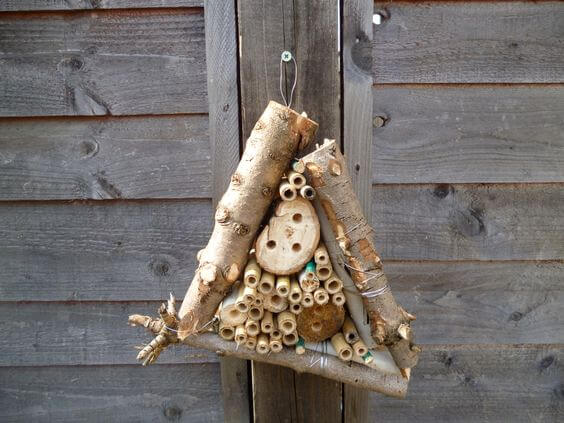
Built entirely from branches, twigs, and hollow stems, it’s both eco-friendly and incredibly charming.
Materials Needed
- 3 thick branches (12–15 inches each)
- 4 small logs
- Hollow bamboo sticks, reeds, or elderberry stems
- Twine, nails, or screws
- Strong wire
Step-by-step Guide
Step 1: Form a triangle with your three branches and secure the corners using twine, nails, or wood glue. Make sure it holds firm.
Step 2: Drill small holes (⅛” to ¼” wide, 2–4” deep) into the logs or wood slices—these will serve as nesting tunnels for bees.
Step 3: Fill the triangle frame tightly with bamboo pieces, small logs, and stems. Alternate the textures for visual appeal and ecological variety.
Step 4: Attach a wire loop at the top and hang your bug hotel from a fence, tree, or wall. Make sure it’s in a dry, sheltered area with some sun exposure.
#13. Tin Can Bee Hotel
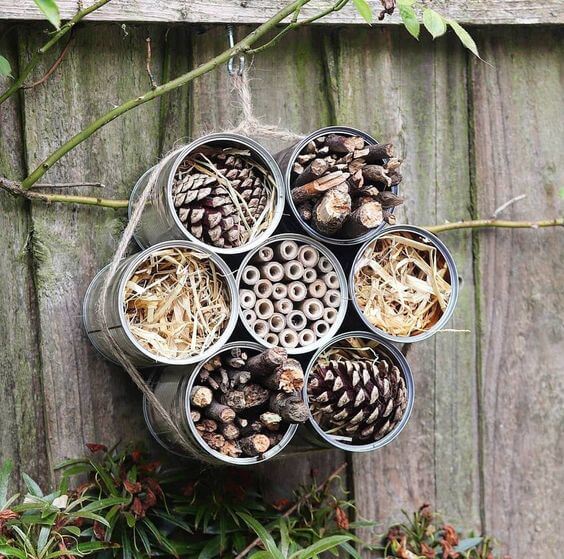
Grouped in a honeycomb-like shape, it’s not just practical—it’s a piece of eco-art for your fence. It’s one of the easiest and most satisfying ways to recycle and give back to nature.
Materials Needed
- 7 clean tin cans
- Natural fillers such as pinecones, twigs, bamboo straws, and hay or straw
- Strong twine
- Heavy-duty glue (optional)
Step-by-step Guide
Step 1: Fill each can with different natural materials—pinecones, short twigs, hay, and small bamboo pieces. Keep the items snug to avoid shifting.
Step 2: Arrange the cans in a flower pattern—one in the center, surrounded by six. Bind them tightly with twine or glue them together at contact points.
Step 3: Tie or attach a loop of twine or wire around the outer edge to hang it from a hook or nail on your fence or shed wall.
#14. Mason Bee House PVC Pipe
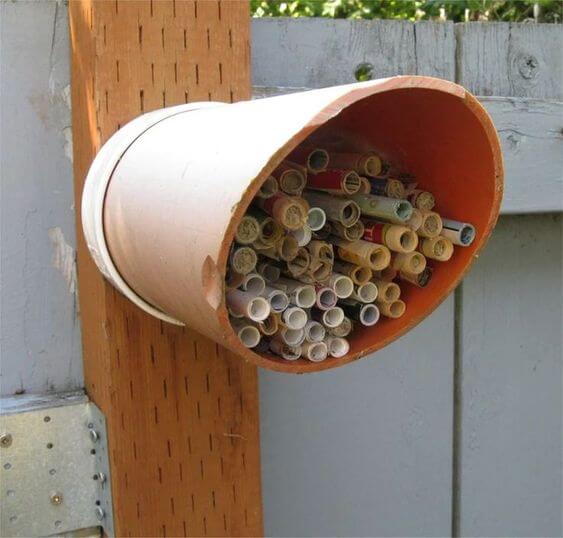
A broken terracotta pot doesn’t belong in the trash—it belongs in your garden, giving shelter to beneficial bugs.
Materials Needed
- 1 broken terracotta pot (ideally 8–10 inches in diameter)
- Bamboo canes, rolled paper cut into 5–7 inch lengths
- Galvanized wire
Step-by-step Guide
Step 1: If using a broken pot, smooth out any sharp edges. Otherwise, use a whole pot turned on its side and supported safely.
Step 2: Fill the pot with tightly packed natural materials—bamboo segments, paper straws, or dry rolled-up paper. Make sure they’re cut to a length that fits snugly inside the pot without slipping out.
Step 3: Secure the pot against a wooden post, tree, or wall using wire or screws and clamps. It should be slightly tilted downward to keep out rain.
Step 4: Place it in a sunny, sheltered spot, ideally about 3–4 feet off the ground, to attract solitary bees and other helpful insects.
#15. Teacup Bee Hotel
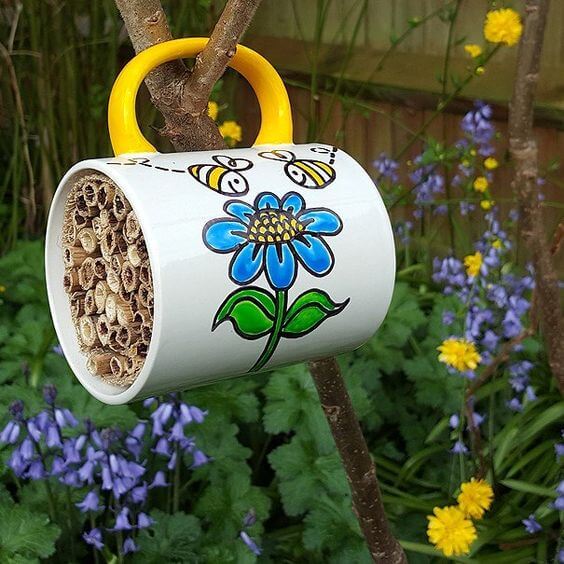
This charming bee hotel transforms an old coffee mug into a whimsical retreat for solitary pollinators.
Materials Needed
- 1 ceramic coffee mug
- Bamboo sticks (about 4–6 inches long)
- Twine
Step-by-step Guide
Step 1: Cut your bamboo sticks or stems so they fit snugly inside the mug without falling out. Vary the thickness slightly to attract different bug types.
Step 2: Pack the bamboo tightly into the mug. It should be firm enough to stay in place even when the mug is jostled.
Step 3: Thread a strong twine through the mug handle and tie it securely to a tree branch or fence post, ensuring it hangs horizontally and slightly downward to keep rain out.
#16. Clay Pot Bee House
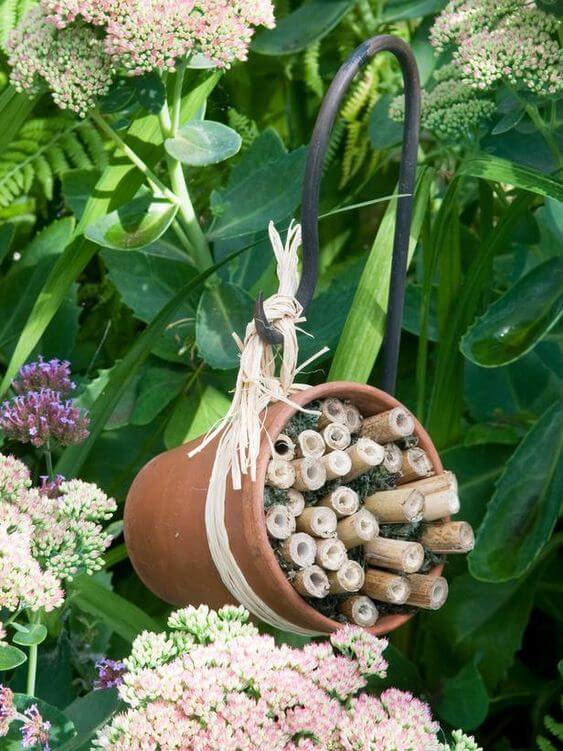
This sweet little terracotta pot tucked among blooming sedum is more than just decorative—it’s a fully functioning bug hotel.
Materials Needed
- Small terracotta flower pot (4 to 6 inches wide)
- Hollow stems
- Garden twine
Step-by-step Guide
Step 1: Gather your bamboo or hollow stems and cut them to fit snugly inside the pot – around 3–5 inches depending on your pot’s depth.
Step 2: Fill the pot tightly with the stems, ensuring they stay firmly in place even when the pot tilts.
Step 3: Thread raffia or twine through the pot’s drainage hole or tie around the rim. Make a strong loop for hanging.
Step 4: Hang the pot upside down or tilted slightly downward to keep water from collecting.
#17. Vintage Terracotta Pipes Bee House
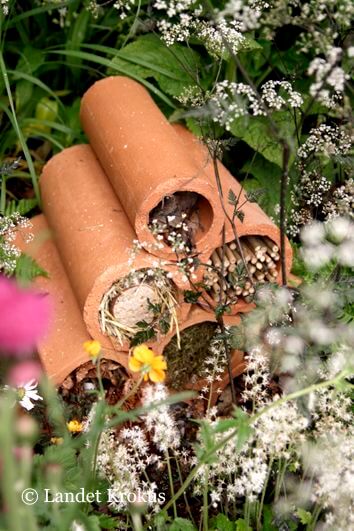
Hidden among the flowers like a secret shelter, this bug hotel uses terracotta drainage pipes stacked into a cozy, functional home for pollinators and other beneficial insects.
Materials Needed
- 6 terracotta drainage pipes, 4–6 inches in diameter and about 8–10 inches long
- Natural fillers (bamboo sticks, dry straw, moss, pinecones, bark, twigs)
- Garden wire (optional)
Step-by-step Guide
Step 1: Arrange them in a pyramid shape: three at the bottom, two in the middle, and one on top. You can secure them with wire or adhesive for extra stability.
Step 2: Stuff each pipe tightly with a variety of natural materials. Mix it up to attract different species, straw for ladybugs, bamboo for bees, moss and bark for beetles.
Step 3: Tuck the structure gently into a garden bed or along a border, ideally near flowering plants. Keep it partially shaded and out of harsh rain if possible.
#18. Wine Cork Bee Hotel
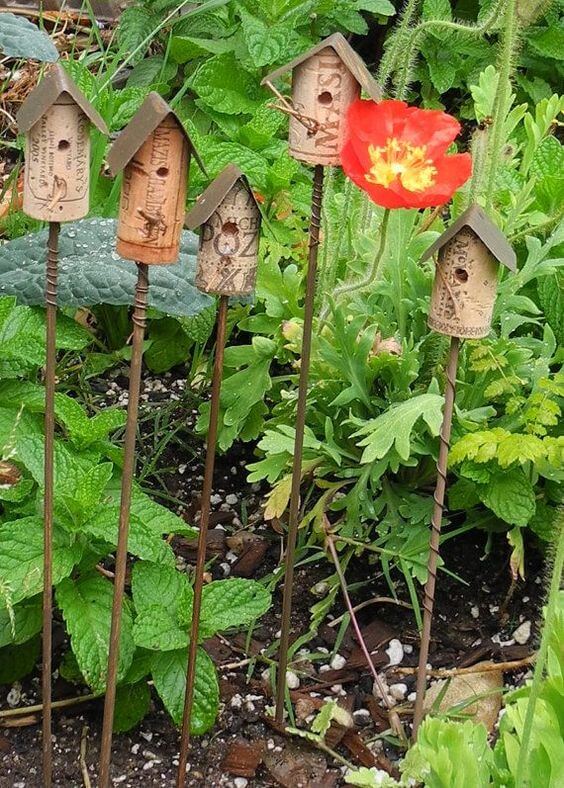
Perched like little watchtowers among the flowers, they offer an unexpected refuge for solitary bees and other tiny insects.
Materials Needed
- 5 to 10 wine corks
- Small sticks (around 18–24 inches long)
- Hot glue gun
- Small drill bit (⅛ inch or smaller)
Step-by-step Guide
Step 1: Carefully drill small holes about ½ inch deep into each cork. These serve as cozy nesting spots for solitary bees.
Step 2: Cut small triangles or rectangles from thin wood to create slanted rooftops. Attach them to the tops of the corks with hot glue.
Step 3: Insert a skewer, metal rod, or wooden stake into the base of each cork. Make sure it fits snugly so the house won’t wobble.
Step 4: Place the finished mini bug houses in your garden, ideally near pollinator-friendly flowers and herbs.
#19. Homemade Bug Hotel Garden Craft
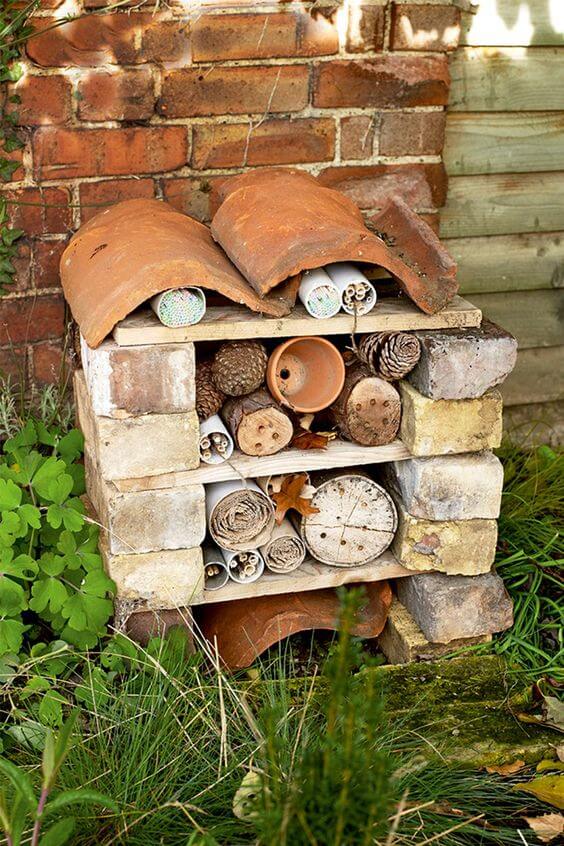
This stacked brick bug hotel is one of the most inviting little homes you could offer your backyard’s tiniest guests.
Materials Needed
- 20–25 bricks
- Terracotta roof tiles
- Wooden planks: 2–3 thin boards, cut to fit (about 14″ long)
- Pinecones, bark, twigs, rolled paper, clay pots, or log slices
Step-by-step Guide
Step 1: Choose a dry, shaded spot near plants or hedges where bugs naturally gather. Create the base with two rows of bricks and place a wooden plank across them to create the first “shelf.”
Step 2: Repeat the brick + plank layers two or three times, depending on the height you want. Make sure each level is balanced and stable.
Step 3: Fill the compartments with rolled papers, drilled wood rounds, pinecones, and even a small broken pot for texture and variety. Mix sizes and shapes to attract a range of insects like ladybugs, solitary bees, and beetles.
Step 4: Place the terracotta tiles on top like a roof to protect the structure from heavy rain. Leave some gaps for airflow.
#20. Brick Bug Hotels
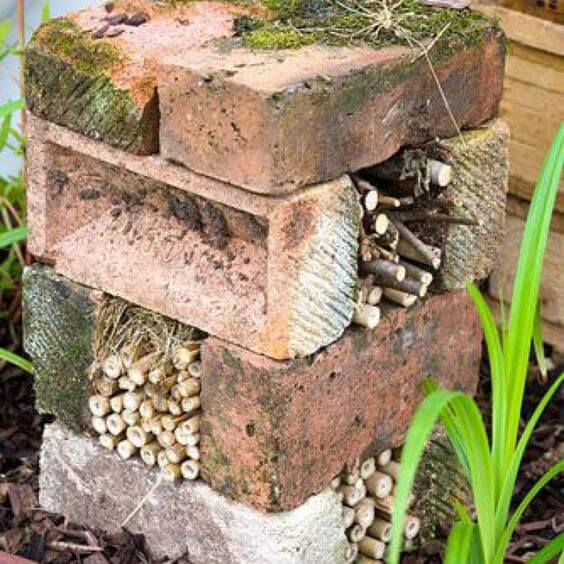
This compact and earthy bug hotel is a no-fuss sanctuary made entirely from old bricks, hollow stems, and small twigs.
Materials Needed
- 8 used bricks with holes
- Bamboo sticks cut to 3–5 inches
- Small dry twigs
- Moss
Step-by-step Guide
Step 1: Fill each hollow or opening in the bricks with either twigs, stems, or tightly packed hollow bamboo tubes. You can group them by type or mix them for texture.
Step 2: Stack another layer of bricks on top, alternating directions to create balance and pockets for bugs to nest. You can add moss or dry grass in between the gaps for extra appeal.
Step 3: Ensure the structure is stable. Gently press down and adjust if it wobbles. If needed, wedge small stones or bits of bark at the base to secure.
